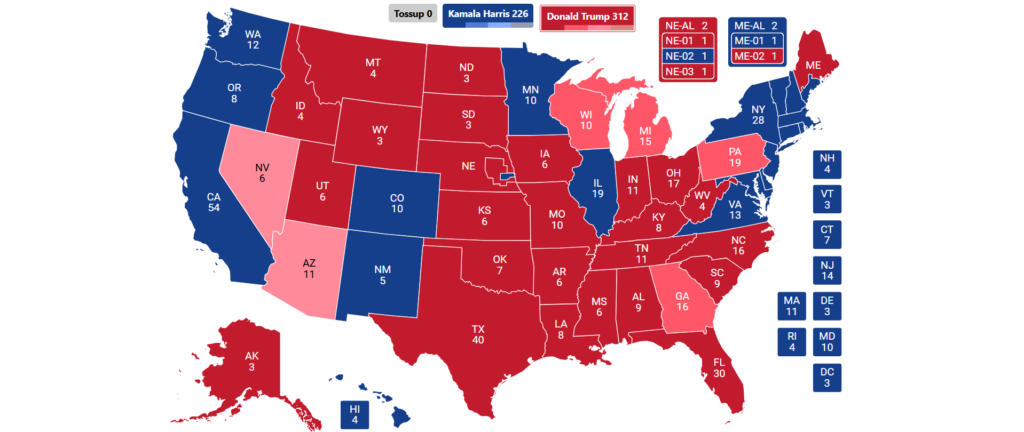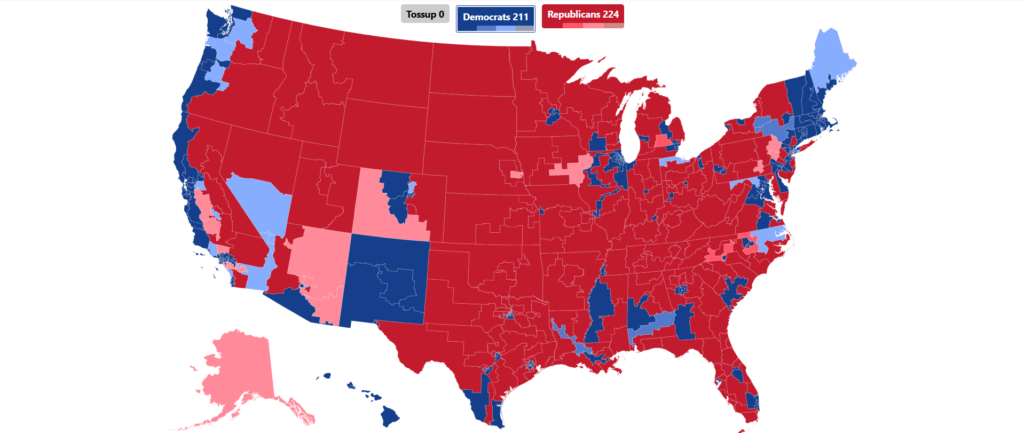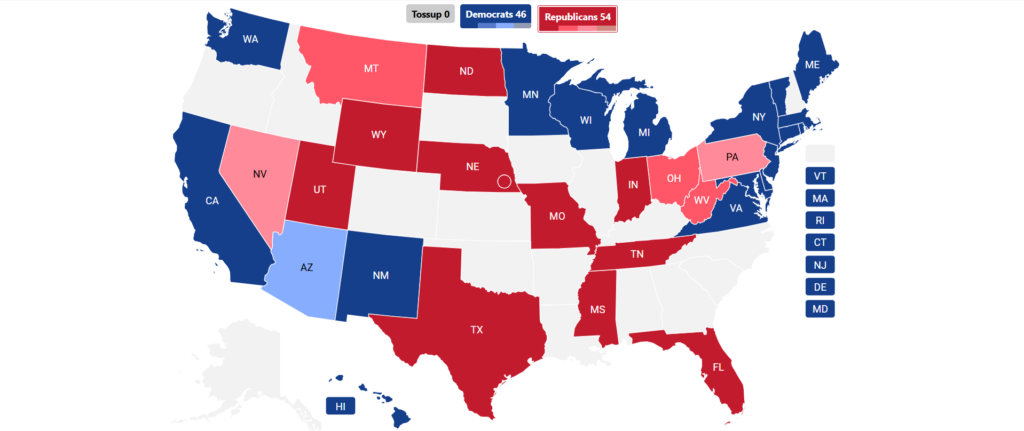Cover photo: Donald Trump gestures to the crowd as he exits his Nassau Coliseum rally (Credit – Matt Meduri)
An election of historic, unprecedented circumstances was endcapped with a result of equal proportions: Donald Trump (R-FL) has defeated Vice President Kamala Harris (D-CA) in the 2024 presidential election.
Trump is now the second president since Grover Cleveland (D-NY), and the first Republican in history, to earn a second non-consecutive term.
“President Joe Biden called President Donald J. Trump to congratulate him on his victory and extended an invitation to the White House to ensure a smooth transition between the current Administration and the incoming Administration. President Trump looks forward to the meeting, which will take place shortly, and very much appreciated the call,” said Steven Cheung, Trump Campaign Communications Director, in a statement.
Vice President Harris spoke at her alma mater, Howard University, in Washington, D.C., urging her supporters to accept the results.
“A fundamental principle of American democracy is that when we lose an election, we accept the results…At the same time, in our nation, we owe loyalty not to a president or a party, but to the Constitution of the United States, and loyalty to our conscience and to our God. My allegiance to all three is why I am here to say: While I concede this election, I do not concede the fight that fueled this campaign,” said Harris.
The Autopsy of Our Forecasts

President
Note: Of the three maps here, the darkest states/districts are called for the respective party. Medium red/blue states/districts are gains for the respective party. Light blue/red states/districts are where the respective party leads but no calls have yet been made.
Last week, The Messenger predicted Donald Trump to win 312 electoral votes, by sweeping the battlegrounds to virtually repeat his 2016 win, gaining only Nevada, and losing only Nebraska’s Second Congressional District.
We also got more granular than other forecasters and offered some margins for the other states. We successfully called a ten-point swing in Trump’s favor in New York, a close race in New Jersey, and drastically decreased margins for Democrats in Illinois, Connecticut, and Delaware.
So far, that forecast is panning out to be almost 100% accurate. While Nevada and Arizona have not yet been called, Trump has five-point leads in both states as of press time. Nevada is only awaiting another 10% of the vote, while Arizona is awaiting about 30% of outstanding ballots.
The only call we made margin-wise that appears to be incorrect was that Florida would vote to the right of Texas. As of press time, Trump has won Texas by fourteen points and Florida by thirteen.
Trump’s first flip of the night came in Georgia, where he is currently leading Harris by two points. Early exit polls from the Peach State showed Trump taking 25% of black male support, and 15% black support overall. Trump was also able to secure decisive margins in both Ohio and Iowa, two swing states considered must-wins for either campaign that now appear to have completely solidified to the GOP’s new working-class-centric message. As of press time, Trump is up eleven in Ohio and thirteen in Iowa.
Trump also managed to defend North Carolina, a state Democrats have not won at the federal level since 2008. He is ahead by three points.
In Texas, Trump effectively erased slow-but-steady Democratic gains there over the years, with Biden coming tantalizingly close in 2020. However, Texas lurched to the right, likely due to his galvanization of Latino voters nationwide. Trump has won all but three border counties, flipping Starr County red for the first time in 130 years and becoming the first Republican to win Maverick County since Herbert Hoover (R-IA) in 1928. Of note, Starr County has the largest percentage of Hispanics in the continental U.S., accounting for 97.7% of its population. Once a landslide county for Democrats, Biden only won by six points here in 2020. Trump won it by sixteen. Trump also stayed within five points in Harris County (Houston), within ten in Bexar (Austin), and swung El Paso County ten points to the right.
Florida is also another death knell for Democrats, as Trump not only won the state by a whopping thirteen points, but flipped once-solidly-blue Miami-Dade County, taking it by eleven points. Trump also trails Harris by just 0.5% in Palm Beach County, a Democratic bastion in southeast Florida. Trump also flipped five key suburban counties: Pinellas (St. Petersburg), Hillsborough (Tampa), Duval (Jacksonville), and Osceola and Seminole (Orlando area). This is the first time since 1988 that Florida went for a presidential candidate by double-digits, voted Republican in three consecutive elections, and a Republican won Miami-Dade County.
In New York, Trump greatly outperformed expectations, trailing Harris by just eleven points in a state that went for Biden by twenty-four points and hasn’t backed a Republican since 1984. Trump cruised in Suffolk County, winning by eleven points, and became the first Republican to win Nassau County since 1988. Trump also flipped Essex and Clinton counties upstate, as well as Broome County (Binghamton), and Rockland County.
In New York City, Trump more or less repeated Lee Zeldin’s (R-Shirley) margins in 2022. Trump took almost 40% of the vote in Queens, 30% in Brooklyn, 30% in the Bronx, and 20% in Manhattan.
New Jersey was also a sleeper state that some outlets didn’t call until early Wednesday morning. For a state that went to Biden by sixteen points, Harris is only up by less than five. Trump has also flipped Passaic County, marking the first time the county has backed the GOP since 1992. Harris also only posted a thin margin in Bergen County.
Democrats also appear to have hemorrhaged badly in Illinois, a possibility we contended based on our conversations with campaign surrogates in New York and New Jersey. Biden took this deeply-blue state by seventeen points four years ago, only for Harris to win it by about eight points. Trump clinched 30% in Chicago’s Cook County, while House results in predominantly-Hispanic districts gave Democrats reduced margins.
Connecticut and Rhode Island were also underwhelmingly won by Harris, posting near-ten-point swings to the right in both.
It took about half of the ballots to be received for CNN to call Delaware for Harris, a state in which we expressed optimism for Trump. Harris is up a little less than fifteen points, which isn’t a considerable swing we expected, but early indications of black voters supporting Trump clearly made this an interesting race at first.
Remarkably, Trump is currently capturing 40% of the vote in California and is leading in traditionally-red Orange County. However, many votes remain uncounted, so these margins might shift significantly over the coming weeks.
In the deep-blue states, Trump is nearing 40% in Hawaii, a remarkable feat, and flipped Orleans County, Vermont, becoming the first Republican to do so since 2000.
Our Presidential Forecast (so far): >95% accurate.

U.S. Senate
The predictions for the Senate weren’t nearly the jump balls that the calls for the presidency were. Almost all pundits agreed Republicans would easily flip West Virginia and add Montana and Ohio to their ranks for a 52-seat majority. We predicted such an outcome, which has materialized, but the GOP might have overperformed in the race for the upper chamber.
So far, no calls have been made that make our forecast incorrect. However, we note that the votes are still coming in from rural Pennsylvania, and David McCormick (R) is leading the iconic Bob Casey, Jr. (D). The Casey name was seen as virtually unbeatable in Pennsylvania, and although we noted the tightening of the race in the closing days, we still believed Casey would hold on due to his name. That seems like that might not be in the cards, as Casey appears unlikely to close the gap based on the votes that remain outstanding.
In Nevada, Sam Brown (R) is surprisingly ahead of Jacky Rosen (D), but by a razor-thin margin, not comparable to Trump’s current five-point lead. While Trump is winning Washoe County (Reno), and just one point away from carrying Clark County (Las Vegas), Brown is lagging in these two crucial counties. With about 10% of the votes remaining, we expect Brown to lose to Rosen, but Trump to carry the state.In Arizona, the race has not been called, but Congressman Ruben Gallego (D, AZ-04) remains in the lead by two points over 2022 gubernatorial candidate Kari Lake (R). Lake’s name recognition suffered immensely over the fallout of that election, and we still think that Gallego is a favorite to hold this seat.
Other than that, there were really no surprises, except, perhaps, of Tammy Baldwin’s (D) squeaker in Wisconsin.
In New York, Senator Kirsten Gillibrand (D) has defeated Mike Sapraicone (R-Floral Park) 58% to 41%. It’s a large downturn from her 2018 victory over Chele Farley (R), but still a comfortable win. Sapraicone has won Suffolk and leads in Nassau. Counties that went for Trump and Gillibrand include Essex, Clinton, Rockland, Orange, Broome, Warren, and Ontario.
Our Senate Forecast (so far): 95% accurate

U.S. House
The race for the House is still up in the air, but Republicans have won 205 seats to the Democrats’ 190, according to the Associated Press. Republicans appear on track to retain the majority by a virtually identical margin with which they began. With no significant underdogs this year, it was tough to see a massive majority for either party.
So far, Republicans have flipped MI-07, NC-06, NC-13, and NC-14, with the latter three being “gimmes” due to an aggressive Republican gerrymander in North Carolina. Republicans appear on track to flip AK-AL, CA-47, PA-07, and PA-08. All of these were correctly predicted in our forecast, with the exception of PA-07, where we thought Susan Wild (D) would narrowly hang on. The votes are still coming in, but it’s not looking good for her.
On the other hand, Democrats, according to our expectations, picked up AL-02 and LA-06, due to court-mandated redraws to include a second black-majority district for each state. Democrats have also picked up NY-22.
Where we are wrong (so far): Congressman Marc Molinaro (R) has lost in NY-19. While the major outlets haven’t yet called NY-04, Laura Gillen (D) is declaring victory over freshman Congressman Anthony D’Esposito (R-Island Park). Gillen currently leads by just two points. Republicans have also failed to flip NM-02, contrary to our expectations of a strong Latino surge for Trump, especially in a border district, as well as working-class MI-08, home to Flint, Bay City, and Saginaw. This one really surprised us, as we expected a Trump win in Michigan to extend coattails to congressional Republicans.
Like MI-08, we were also wrong in one of our earliest predicted flips: OH-13. Amazingly, despite Trump winning Ohio by a historic margin, Congresswoman Emilia Sykes (D) has held on by two points.
IL-17 also stayed with Congressman Eric Sorensen (D), even as Trump vastly exceeded expectations in Illinois.
We also appear to be wrong in our forecast of NE-02, where Congressman Don Bacon (R) is miraculously holding on despite being more of an underdog this cycle than he ever has been.
While the vote is still out, Congresswoman Lori Chavez-DeRemer (R) is trailing narrowly in OR-05, a seat we thought she would hold.
David Schweikert (R) is also holding on in the Phoenix-based AZ-01, contrary to our expectations. The vote is still out, but Arizona is shaping up to be much more fortuitous for Republicans than some thought.
Although we were wrong in a few seats, we rightly put all of the aforementioned districts on our “upset watch” list. While none of these are real shockers, we’ll say that MI-08 is the result that surprised us the most.
Republicans currently have a net gain of one seat in the lower chamber, while they currently lead in nineteen. If they win every seat in which they lead, they walk away with a 223-seat majority, just four short of the 227 majority we had predicted. The only ones we’re not too confident on for them are AZ-01, AZ-06, and CA-41, which could go either way at this point.
Democrats currently lead in twenty-five seats, the lion’s share of which we expect to remain in with them. The only places we think the votes could turn around are CA-09, CA-21, CA-49, NY-04, and OR-05. It would be unlikely to see Republicans win tight races in Nevada, Maine, Ohio, and Washington state at this point.
If the races hold as they currently are, the GOP will have a 224-seat majority.
Our House Forecast (so far): ~90% accurate
Gubernatorial Elections
There was really no action to speak of on this level, allowing all forecasters and pundits alike to score an easy “100% accuracy” rate on this one.
Republicans easily defended their seven “safe” targets, while Democrats defended Delaware, although the twelve-point win should be of concern to Democrats.
In Washington, Bob Ferguson (D) continued Democrats’ longest guber-natorial winning streak in the country, which dates back to 1980. The margin is about thirteen points, not as much of a push from Dave Reichert (R) as we thought. We’ll dock ourselves a point for assuming he’d do better.
In North Carolina, a real race was brewing until it fully unraveled for Mark Robinson (R). Josh Stein (D) won by a fifteen-point landslide.
That left New Hampshire as the lone toss-up, which we correctly predicted would go to former Senator Kelly Ayotte (R). However, Ayotte decidedly outperformed Trump, as she won the state by almost ten points, while Harris won it by just under three. We’ll dock ourselves another point for assuming Ayotte would only win narrowly.
Our Gubernatorial Forecast: 98% accurate




